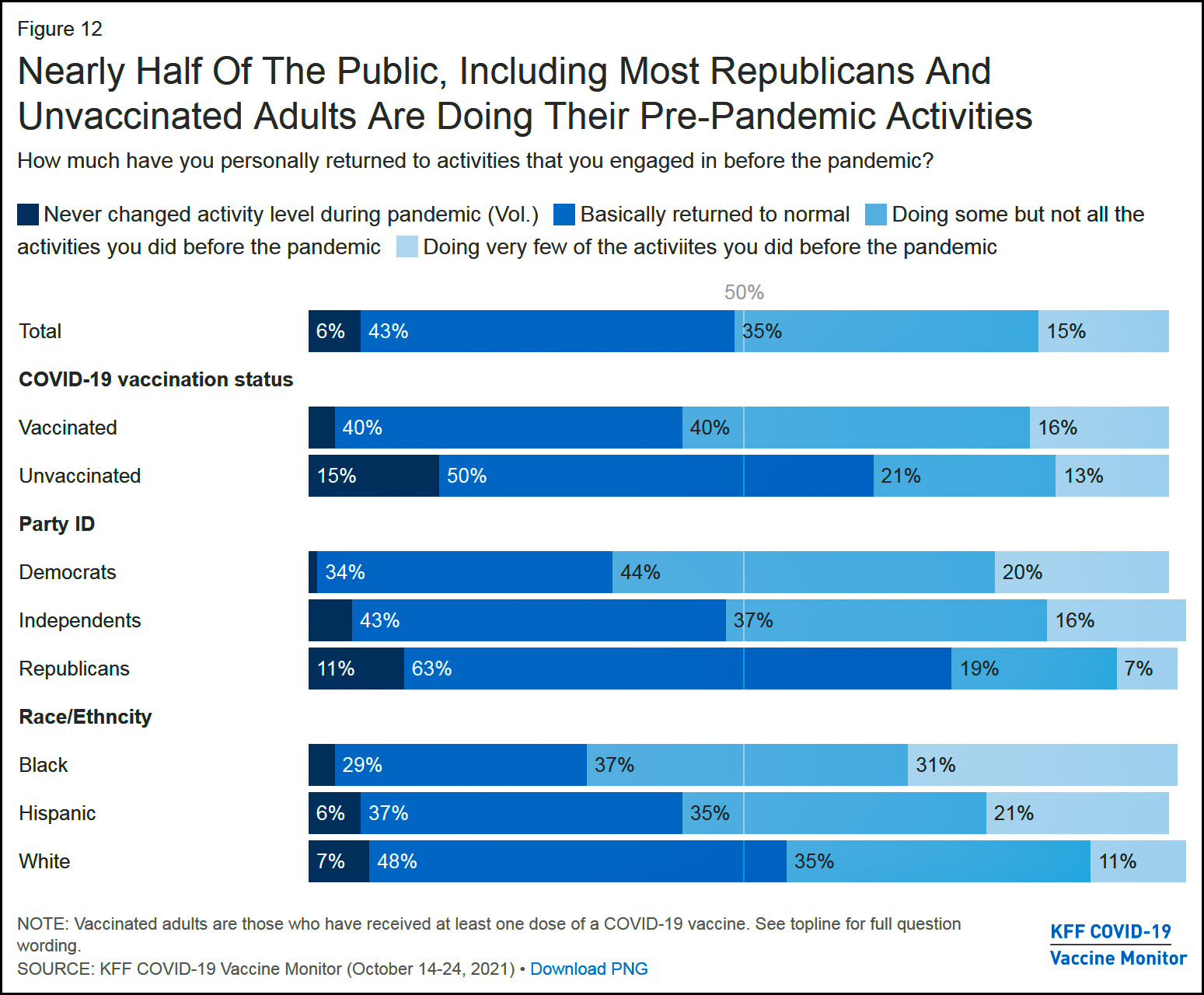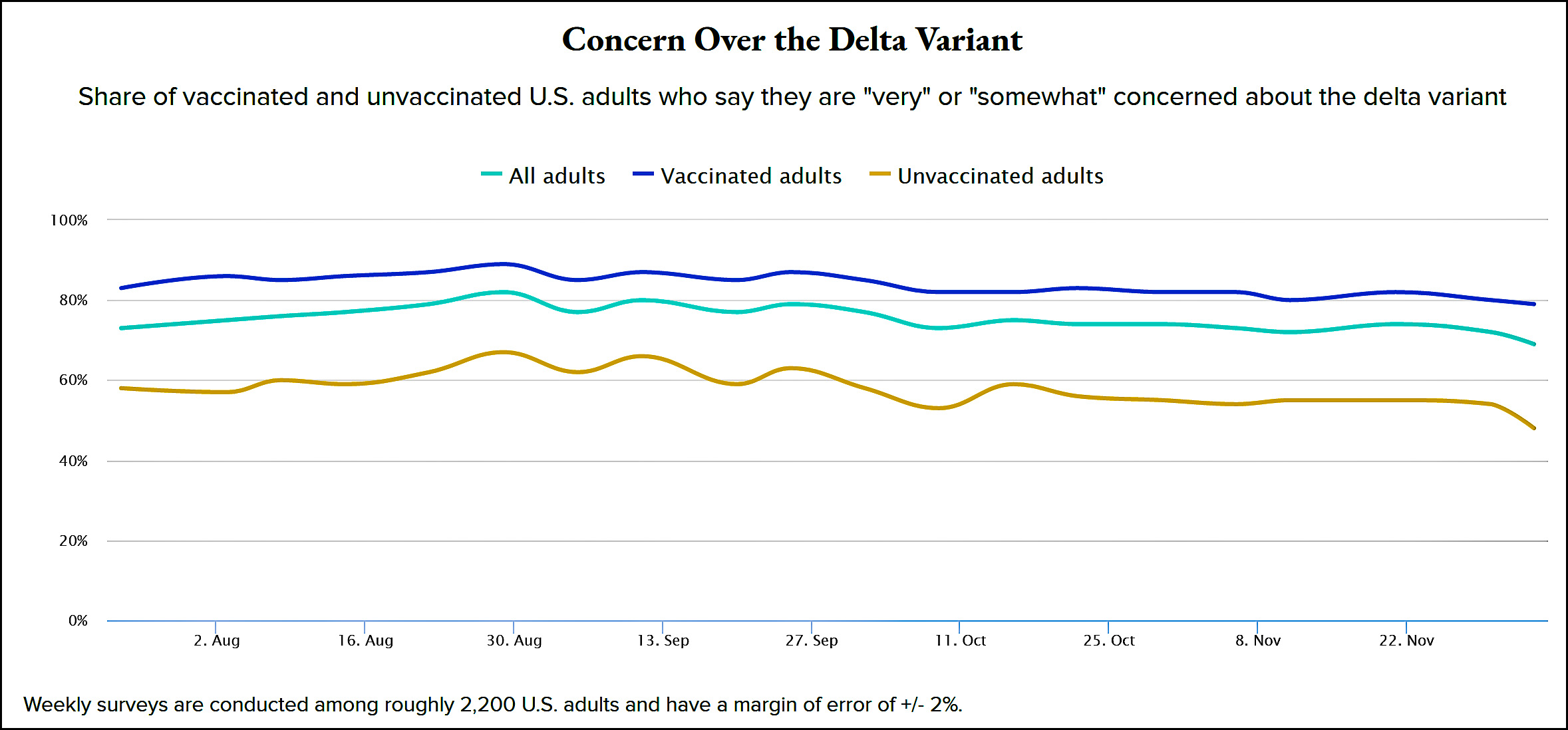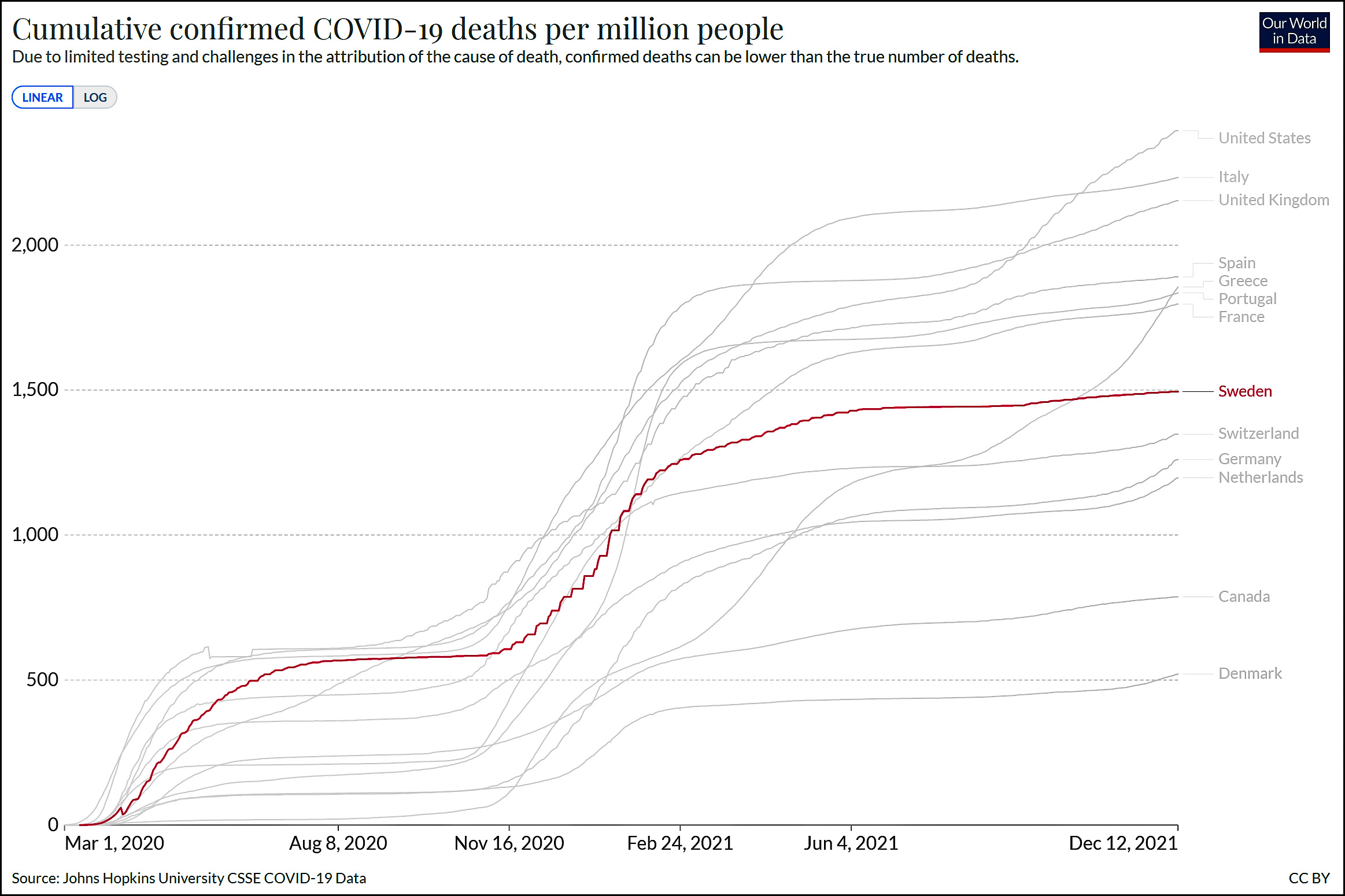Over at the Atlantic, Matthew Walther has a piece today about life during the pandemic:
Where I Live, No One Cares About COVID
Outside the world inhabited by the professional classes in a handful of major metropolitan areas, many Americans are leading their lives as if COVID is over.
The title is not clickbait: Walther argues explicitly that nobody in his rural Michigan community cares a whit about COVID. Nobody wears a mask, nobody avoids crowds, nobody gets tested, nobody ducks play dates for their kids, etc. Presumably some substantial number of people have gotten vaccinated, but otherwise Walther claims that everyone leads normal lives even though COVID is about as deadly now as it's ever been.
Walther is getting massively dragged on Twitter for this, but I was kind of fascinated by his piece since I happened to write something similar just a few days ago:
I suspect that part of the public anxiety over COVID is due to the gigantic mismatch between rhetoric and reality. We are told loudly and often about how bad the COVID pandemic is. We have mask mandates, vaccination mandates, travel restrictions, business shutdowns, deep cleanings, remote schools, and constant reminders of how many people have died. And yet, the reality today is that most of us have only the tiniest sliver of a chance of dying from COVID-19.
Before commenting on Walther's views, I was first curious about whether he was actually right. That is, are lots of rural people simply leading normal lives and ignoring COVID? This is a tough one to answer, but here's something close from the Kaiser Family Foundation's tracking poll:
 This doesn't report results for rural and urban, but it does report that 74% of Republicans say they are currently leading normal lives. Overall, 49% of adults say they're leading normal lives. On the other hand, there's also this:
This doesn't report results for rural and urban, but it does report that 74% of Republicans say they are currently leading normal lives. Overall, 49% of adults say they're leading normal lives. On the other hand, there's also this:
 This tells us that although concern about COVID has declined slightly since summer, about 70% of all adults are still concerned about it. This isn't surprising, since you can hardly avoid thinking about COVID given that it's splashed across practically every news broadcast.
This tells us that although concern about COVID has declined slightly since summer, about 70% of all adults are still concerned about it. This isn't surprising, since you can hardly avoid thinking about COVID given that it's splashed across practically every news broadcast.
So I'd guess that Walther is partly right and partly wrong. The behavior he sees might very well be mostly normal. However, what people feel is probably different. I'll bet there's more fear and concern about COVID in his hometown than he thinks, even if people mostly try to fit in by pretending nothing is amiss.
The funny thing about all this is that I'm closer to agreeing with Walther than I would have been a year ago. I think he's wrong about masks, which have become the great political statement of our time despite pretty good evidence that they work. However, it's also true that the best evidence seems to indicate that they have a modest effect, not a huge one.
As for all the other countermeasures, it's genuinely unclear how effective any of them are. I'm not arguing one way or the other here, just saying that the evidence isn't yet conclusive for most countermeasures. Do you remember the great Sweden Experiment? They mostly lived life normally and their infection rate was pretty high. But I kept saying I wanted to wait and see how things ended up when the pandemic was over. We're not there yet, but we're a lot further along and Sweden isn't looking so bad anymore:
 Sweden is no great shakes, but they also aren't looking terrible. Wait another few months and they might even be ahead of former COVID stalwarts like Germany and Switzerland.¹
Sweden is no great shakes, but they also aren't looking terrible. Wait another few months and they might even be ahead of former COVID stalwarts like Germany and Switzerland.¹
So far this has all been a bit speculative on my part, but one thing isn't: our appalling approach to closing schools. From the very beginning the evidence has suggested that closing schools was a bad idea, and that evidence has only gotten stronger over time. If there's anything that's soured the public on COVID countermeasures, this is surely it. Masks are a mild inconvenience at worst, but shutting down schools is practically existential for parents of school-age kids—not to mention the kids themselves. And the endless back-and-forth over school closures just makes it worse. Even if schools were more dangerous than they are, it's hard to believe that closing them has ever come close to balancing out the harm of keeping kids at home. Our elite class (or whatever you want to call them) wrecked their reputation big time over school closures.
This has turned into a long ramble, so let me sum up:
- Walther says everybody in his rural community has returned to their normal, non-COVID life. With a bit of allowance for hyperbole, polling evidence suggests he's probably right.
- However, it's likely that more people care about COVID than Walther thinks.
- Walther explicitly argues that all us urban liberal types have overhyped the need for cumbersome countermeasures. I think he takes this too far, but he may have a point.
- Chief among these cumbersome countermeasures has been school closures, which never should have become as widespread as they did.
I'm open to argument on all this stuff. It's basically just a brain dump of where I am right now.
¹It's worth noting that Sweden has tightened up its countermeasures since last year, which might account for some of their recent success. However, their mandates are still pretty weak compared to most countries.

Jesus, the liberal hive mind is so stupid on this topic. Look at these comments. We are no longer the reality based community.
A highly effective vaccine is widely available for free. A highly effective treatment is about to be approved by the FDA. If that's not enough, what will be? Please advise.
Most liberals are vaccinated and are simply going about living their lives. There are just a few loud voices in the intelligentsia who seem to want pandemic panic to last forever.
"If that's not enough, what will be?" The problem is that we still see more than 1000 deaths per day due to covid in this country. While those deaths are mostly amongst the unvaccinated, oddly enough I still have empathy for them, and want to do my part to reduce the spread of COVID so that fewer of them die. (I also have an 89 year old mother living in an independent living facility, as well as good friend whose mother is going through chemo, so have personal-circle reasons to be careful as well).
What would my threshold be? I don't know. Maybe 100k deaths a year, so about 270 deaths/day? That is somewhat arbitrary. It is about twice the mortality of the worst flu season of the past decade, so at that point we could think about switching to "what we do for bad flu seasons". (though honestly, we should probably do more. for flu... I admit to sometimes missing my flu shot, and sometimes going to work when I was feeling wonky, and maybe we should change societal expectations there. Maybe even masking in public transit in flu season...).
A fairly effective vaccine is widely available for free. A fairly effective treatment is about to be approved by the FDA. If, in fact, both were "highly effective", and if essentially the whole eligible population was vaccinated, that might well be enough.
And someone I know who is from SW Michigan says its BS. Says that maybe half the people you see in a randomly chosen small town are masked.
The likelihood is that Walthers is very cloistered in a group of maybe 20 people who don't mask. Their isolation protects them.
This might well vary from one town to the next, now I think of it. Some taking it seriously, others ignoring covid.
I live in Tampa (a blue city in a blue county). When I go to the grocery store, Target, or any other place, less than 10% of the people are wearing masks. Since the the vaccines came out and the CDC said vaccinated people don't have to wear them indoors, all the stores stopped requiring them and people, for the most part, stopped wearing them.
I went to a Bucs game a few weeks ago. I saw maybe 5 people wearing masks. I was not among them. I think it was fine.
My last trip to the Mall of America was similar. About 10% masked. And that may be artificially high, since they have a child vaccination site there that requires masks. Lots of the people wearing masks were going to or from the vaccination site
FWIW: on rural areas: http://irjci.blogspot.com/2021/12/rural-coronavirus-vaccination-rate-has.html
Anecdatum: Red county in a blue state, I have noticed more people (let's say fifty percent) wearing masks in the grocery store just very recently. I think that omicron has people spooked. Not the incorrigibles, of course, but the sane center who had eased off wearing masks last summer.
Blue area in red state here. Pretty much 100% masked in grocery store, though some showing their noses. Life has largely resumed, though when daughters and I tried going to one of our favorite restaurants yesterday, it had been killed by the pandemic. Same with our second choice. Very sad.
However, unless Omicron starts killing in unprecedented numbers, don't think we'll go back to lockdown. We're frogs swimming in the boiling water.
I think KD has some misstatements or omissions in this posting (masks actually work better than he says, not comparing Sweden with Norway, the early school response did not have a predicate)- when James Joyner in Outside the Beltway has a more salutary response than KD on the same Atlantic column we know we have stepped over some type of rubicon.
BREAKOUT
500 cases at Cornell in Ithaca NY:
https://www.cnn.com/2021/12/14/us/cornell-university-covid-cases/index.html
A delta surge while Omicron is spreading?
Wonder what that would mutate into?
I'll give another data point from a place that pretty closely matches the profile of the rural Michigan of the Atlantic article. I was at the Sunday night Packer Bears game at Lambeau (capacity of 80k). I spent about five and a half hours in the Titletown area, the atrium, under the stadium, and in two sections for the game. So I probably saw about 1000-1500 people up close in all those various spots. I saw 6 people, total, wearing masks. 7 if you count me.
That's in Brown County, with a 75 per 100,000 daily infection rate right now, roughly 8x higher than where I live in California.
The NFL has a big problem - from Charles Robinson NFL columnist
After setting a single-day record for COVID positives across the league Monday, the Los Angeles Rams were forced to close their team facility on Tuesday, while the Cleveland Browns also moved into the league’s enhanced protocols after placing eight players — including four starters — onto the COVID reserve list. The NFL hit a single-day high of 37 positive tests among players Monday, then rolled into Tuesday with the Rams and Browns both bracing for more positive tests.
As of Tuesday, the league’s COVID reserve list had ballooned to nearly 100 players, with the expectation that number will climb over the course of the week.
************************************************
I suspect Omicron but MOST of the NFL players got vaccinated months ago. They will need to run tests to determine the variant.
The schools question is a total mess. No matter what was decided, it was going to massively hurt public education. Where I am the schools were closed, and many families ditched the public schools for private schools that stayed open.
But there were enough parents and teachers opposed to in person learning, and no amount of precautions (in pre-vax times) was going to make them willing to be in a classroom. There is no way our district would have survived the mass Exodus of teachers and students if they tried to stay open.
We are now open, with some precautions and teachers vaccinated. Turns out that masking elementary students and having them sit apart at lunch works really well to limit spread at school. There are cases among kids, but very little seems to be spreading between classmates.
I volunteer at a school where I am exposed to all 600 kids every single week (no individual teacher in the building sees that many kids in a week), and it has felt just fine being there. I mask, as do the kids. I have also limited my personal activities massively, since I did not want to catch covid and be the cause of kids quarantining.
The truly scary thing is the hit to their learning. So many kids are behind, especially the 2nd and 3rd graders in reading. The racial and wealth gaps in education have grown considerably over the last two years.
We didn't close the schools for the kids, we closed them for their families. Literally millions of US seniors live with school aged children in the house.
We've had 3 infected kids in the past 4 weeks alone in our tiny and super careful NYC private school, and that's with all staff and most kids over 5 vaccinated. We're STILL getting cases.
So I'll admit I'm confused -- Kevin's plan way back when, pre-vaccine, was to... keep the schools open and have happy asymptomatic carrier kids sicken their parents and kills their grandparents? Or for all school children with adults in the house isolate after they get home?
Closing the schools sucked, and I say that as a parent who knows and has seen how my kid has fallen behind where he should be. But it had to be done b/c it was the least terrible option.
What am I missing?